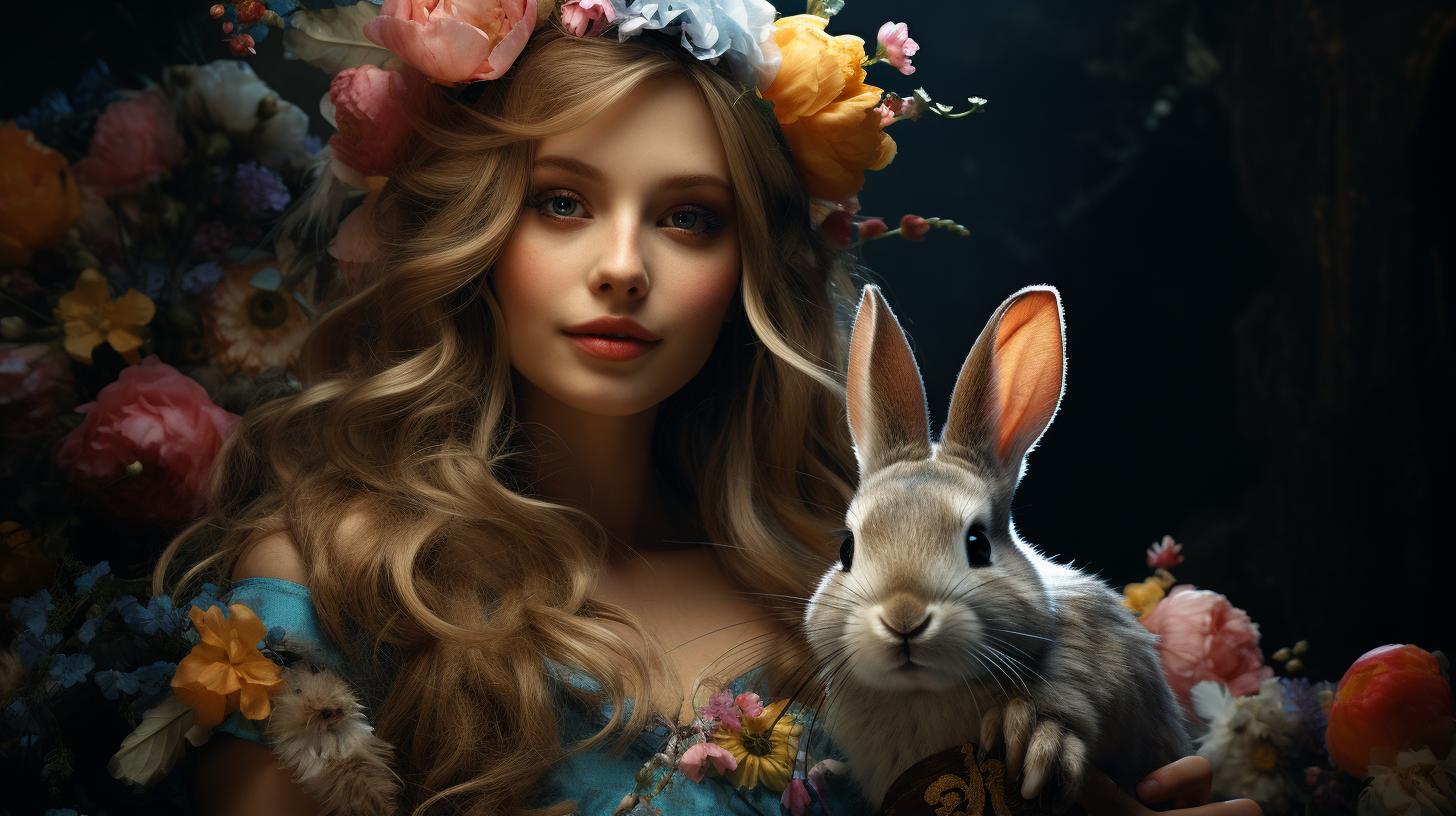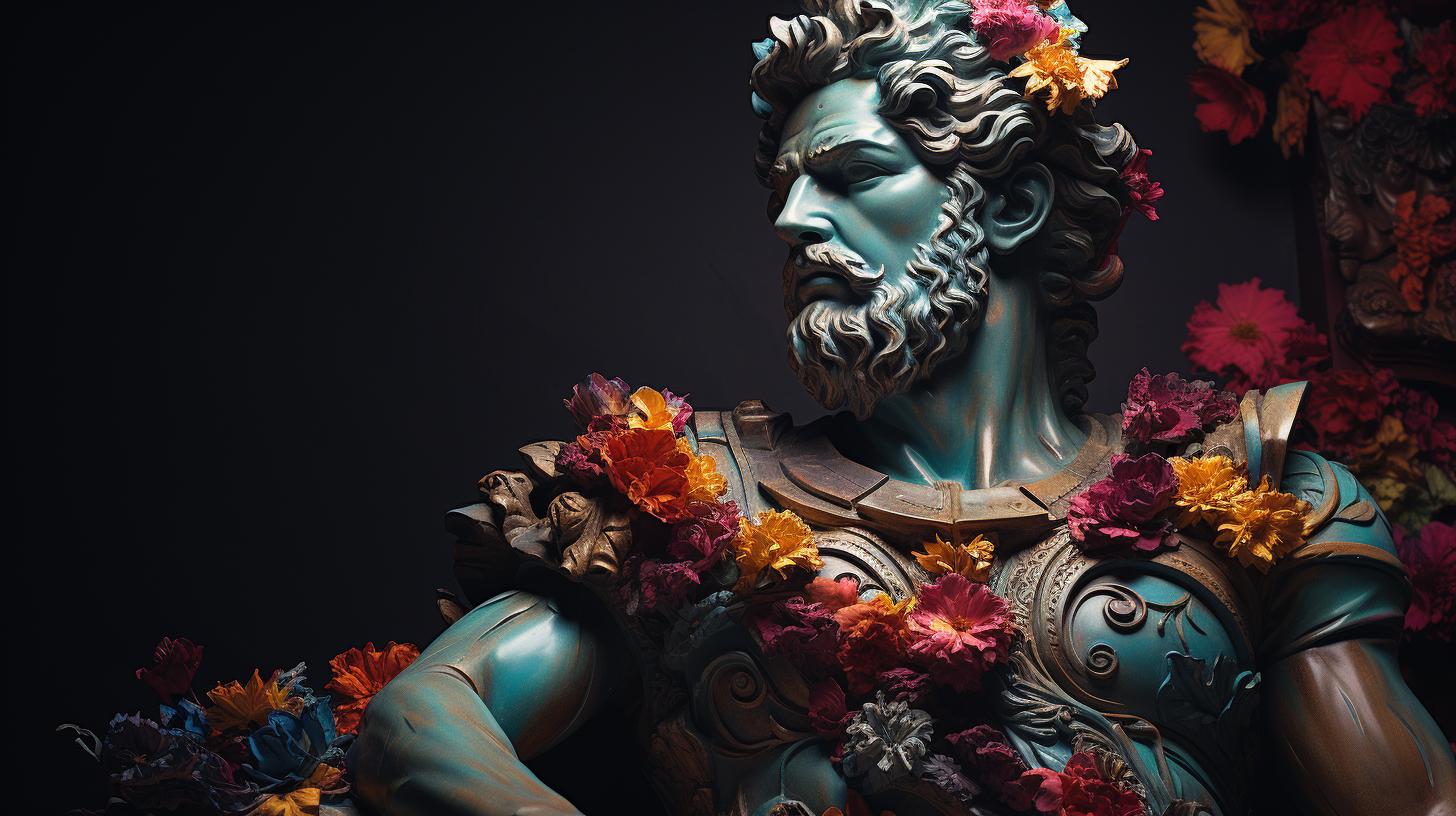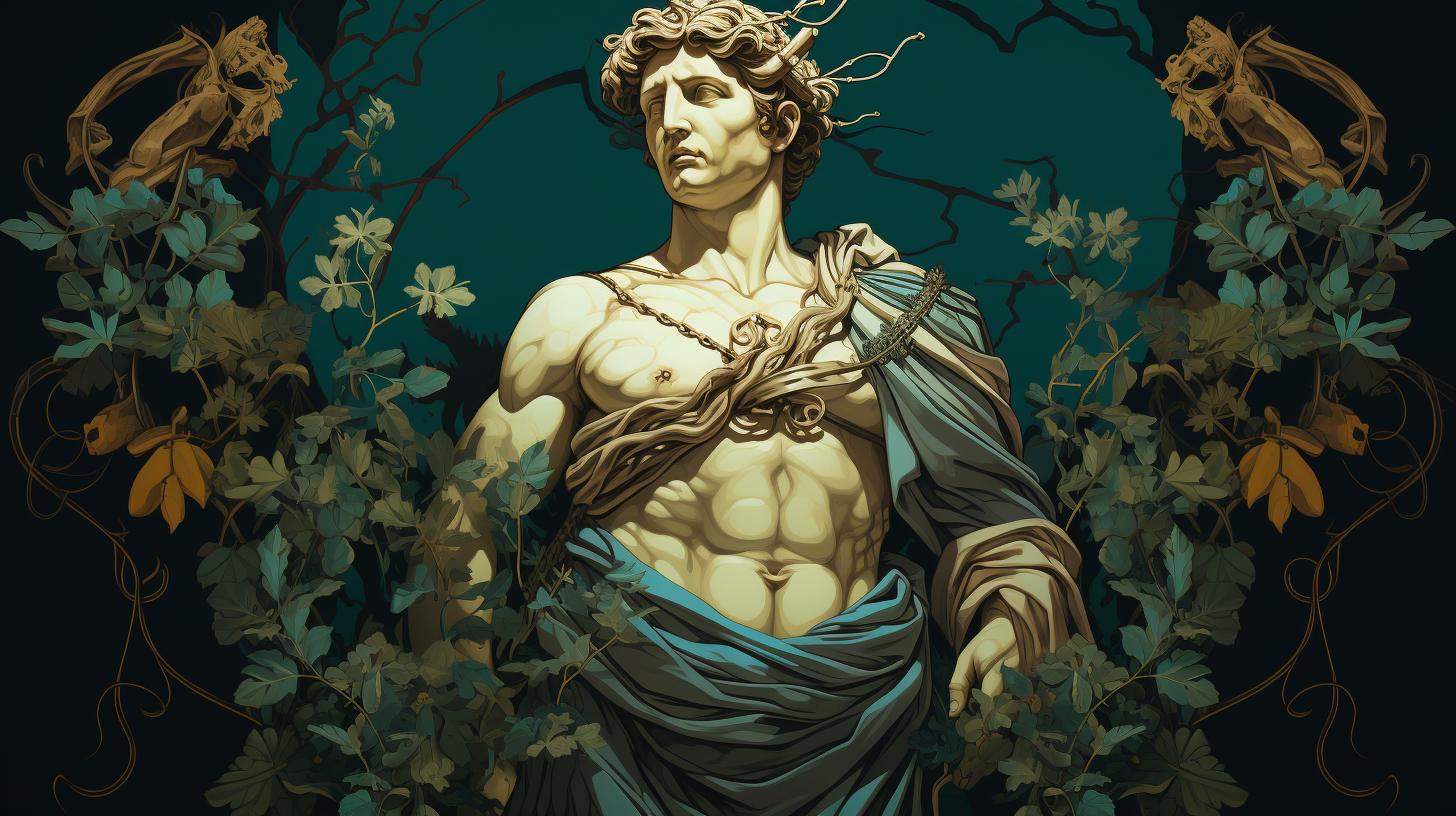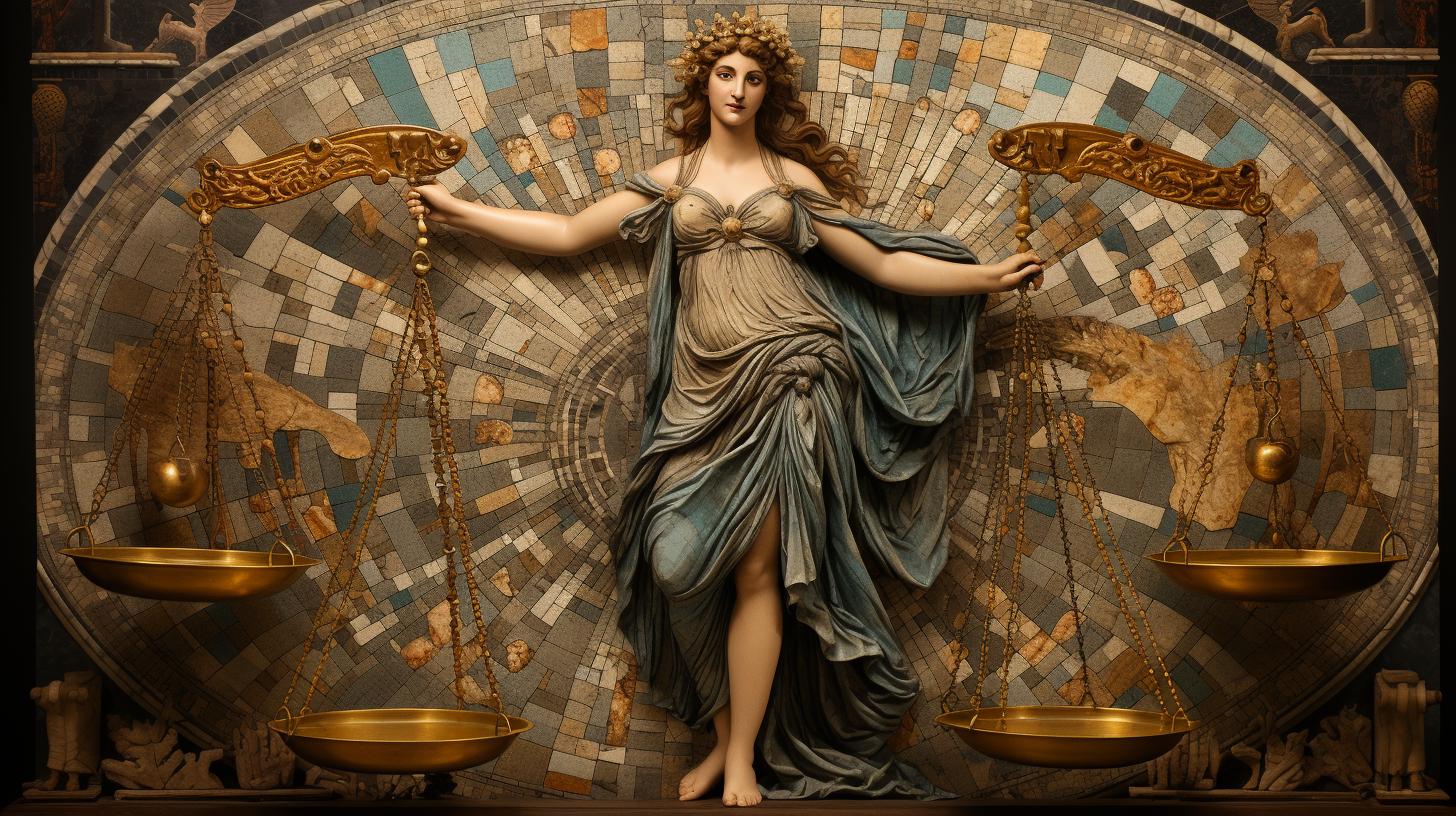Exploring the Enigmatic Roman Goddess Fauna: A Tale of Fertility and Power
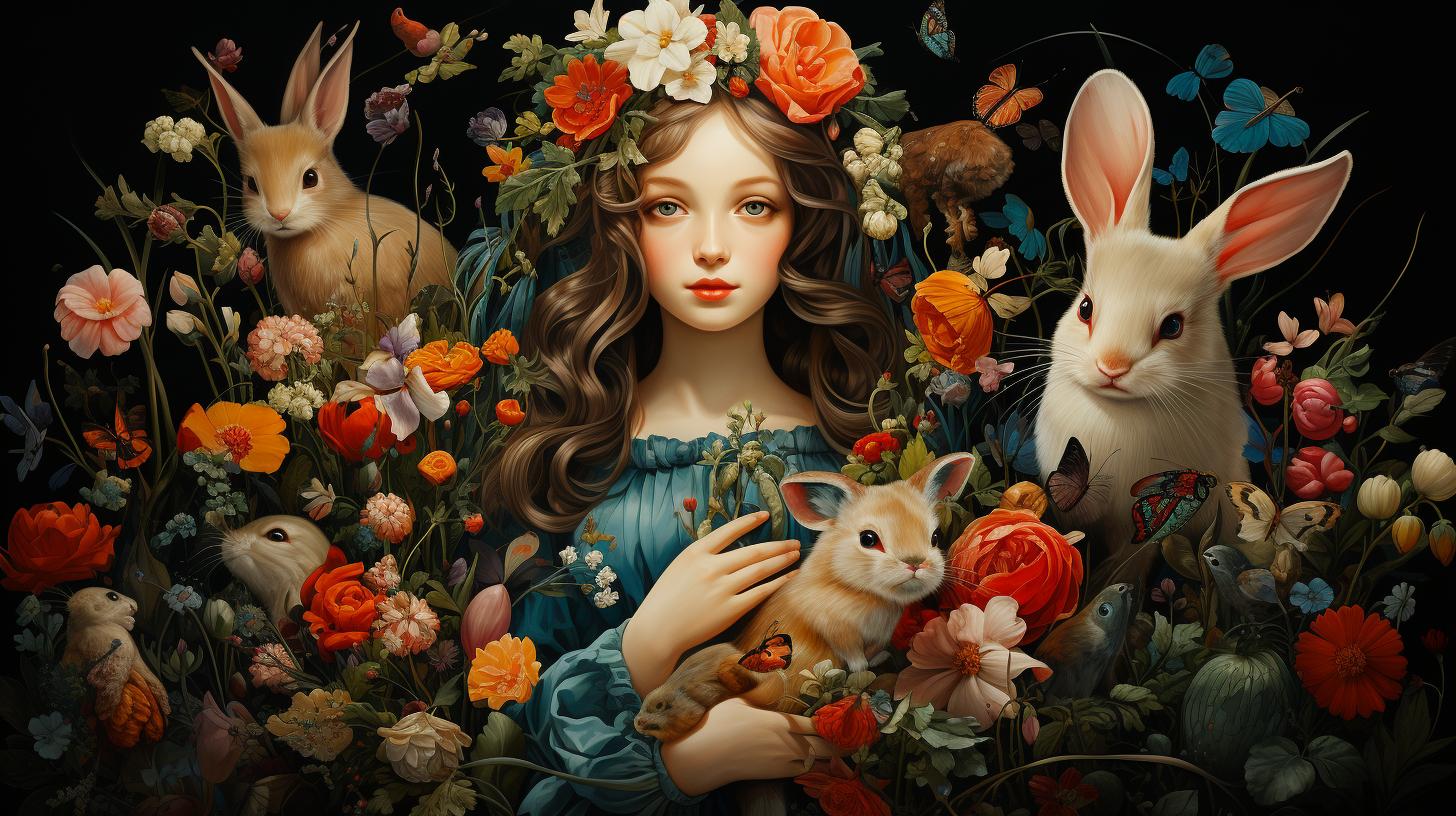
Fauna, the Roman goddess associated with fertility and wildlife, holds a significant place in ancient Roman religion and mythology. Believed to be either the wife, sister, or daughter of the renowned deity Faunus, Fauna’s origins lie in Latium, the land of the Latins.
Her intriguing connection to the god Faunus provides insight into her attributes and personality. Often compared to the mischievous fauns, Fauna embodies the untamed spirits of the fields and forests. Additionally, she is closely associated with Bona Dea, the Roman goddess of fertility, healing, and women.
Together, they form a captivating narrative of power and reverence in Roman culture.
The Role of Fauna in Ancient Roman Religion
In ancient Roman religion, Fauna played a significant role as one of the lesser-known goddesses. She was revered for her association with the fertility of forests, fields, and animal herds. While there are varying accounts of her relationship with the god Faunus – whether she was his wife, sister, or daughter – Fauna’s origins can be traced back to Latium, the land of the Latins.
As an ancestral figure of the Roman people, she held great importance in their religious beliefs.
According to mythological accounts, Fauna’s union with Hercules resulted in the birth of her son named Latino. Latino would go on to become the legendary king of the Latins and a mythical ancestor of the Romans themselves.
However, other tales attribute Latino’s parentage to Faunus and the river nymph Marica. These stories shed light on Fauna’s complex connections within the Roman pantheon.
While we may have more information available about Faunus, the stories surrounding this ancient and popular deity can provide insights into Fauna’s attributes and personality. Faunus was a revered god who protected livestock and roamed the fields and forests.
He possessed prophetic abilities, often revealing the future through dreams and his ethereal voice. Fauna, being the female counterpart of Faunus, is also associated with fauns – mischievous and wild spirits of the countryside.
It is worth noting that interpretations of Fauna’s role as a goddess of fertility sometimes label her as a prostitute or courtesan. However, this perception is likely a later interpretation of her fertility-related responsibilities.
It is through her association with the Bona Dea, a Roman goddess of fertility, healing, and women, that Fauna gains further significance. In some accounts, Bona Dea is believed to be none other than Fauna herself, revered exclusively by women and celebrated with strict rituals and restrictions.
As a goddess intertwined with the wild forces of nature, one can find connections between Fauna and other nature-based goddesses such as Flora, Gaia, Maia, and Terra.
Overall, Fauna’s role in ancient Roman religion encompassed fertility, prophecy, and the untamed beauty of the natural world. Exploring her stories and connections with other deities offers valuable insights into the religious beliefs and cultural expressions of the Romans.
Fauna and Faunus: The Divine Relationship
Within ancient Roman mythology and religion, the enigmatic goddess Fauna shares a deep and intertwined connection with the renowned deity Faunus. Although their relationship varies across different sources, they are often depicted as spouses, siblings, or even parent and child.
This divine relationship highlights the significance and influence that Fauna held within Roman culture.
Faunus, a revered god associated with pastoral life and fertility, is most commonly seen as Fauna’s counterpart. Together, they embody the vital forces of nature and the untamed spirits of woodlands and fields.
The complex bond between Fauna and Faunus showcases the interplay of masculine and feminine elements, symbolizing the harmony between wild and cultivated aspects of life.
As a goddess of fertility, Fauna’s association with Faunus speaks to the importance of reproductive abundance in the natural world. They embody the cycle of life and growth, overseeing the fruitful connection between the forests, fields, and animal herds.
Fauna’s presence amplifies the power of Faunus, creating a harmonious balance that sustains the Roman way of life.
In Roman literature and mythology, the tales and representations of Faunus often shed light on the attributes and characteristics of Fauna. Faunus is known for his prophetic abilities, believed to reveal the future through dreams and his disembodied voice.
These aspects possibly extend to Fauna as well, suggesting her connection to divination and the mystical realm.
While the precise nature of their divine relationship may be elusive, the captivating union between Fauna and Faunus is an integral part of Roman mythology and spirituality. Their ethereal connection represents the profound reverence and recognition of both wild and cultivated elements within the natural world, embodying the delicate balance between humanity and nature.
Fauna, the Roman goddess, holds a significant association with the fertility of forests, fields, and herds of animals. As an ancient deity, her origins trace back to Latium, the land of the Latins, where she is considered an ancestral figure of the Roman people.
While there are variations in the accounts of her relationship with the god Faunus, she is commonly depicted as his wife, sister, or daughter.
In Roman mythology, Fauna’s role as a goddess of fertility extends beyond mere procreation. She embodies the bountiful essence of the natural world, bringing life, growth, and abundance to the fields and the wild.
As a guardian of the animal kingdom, she ensures the flourishing of livestock and the harmonious coexistence between humans and nature.
Many tales depict Fauna’s connection to the legendary hero Hercules, with whom she is said to have had a son named Latinus. Latinus, in turn, became the mythical ancestor of the Romans and the king of the Latins.
Another narrative suggests that Faunus, the god of the forests and fields, fathered Latinus with the river nymph Marica. These stories intertwine Fauna’s lineage with the regal lineage of the Romans, reinforcing her significance in their cultural identity.
It is worth noting that Fauna’s representation as a prostitute or courtesan is likely a later interpretation of her role as a fertility goddess. In this context, her associations with sensuality and desire are linked to the primal forces of creation and growth.
Within the realms of Roman religion, Fauna is closely connected to Bona Dea, a goddess revered for her powers of fertility, healing, and protection of women. Some believe that Bona Dea‘s true name was Fauna, further strengthening the ties between these two deities.
The worship and celebrations dedicated to Bona Dea, often exclusive to women, involve various rituals and prohibitions, emphasizing the sacred nature of her domain.
Fauna’s mystical connection to the lunar symbolism adds depth to her character. Just as the moon waxes and wanes, she embodies the cycles of nature, including birth, growth, and renewal. This lunar aspect enhances her role as a goddess closely associated with fertility and the fertility rites observed by the Romans.
While Faunus, her male counterpart, is better documented in Roman lore, his stories and attributes provide insights into Fauna’s characteristics. Faunus is known for his prophetic abilities, being able to reveal the future through dreams and his ethereal voice.
These traits may hint at similar attributes present within Fauna, unveiling her potential as a goddess capable of divinations and oracular revelations.
- Fauna’s role as a goddess of fertility and her connection to the fields and forests
- Varying accounts of her relationship with Faunus
- Her association with the mythical figure Latinus and her ancestral ties to the Romans
- Exploration of her depiction as a prostitute or courtesan within the context of her role as a fertility goddess
- The close association between Fauna and Bona Dea, the goddess of fertility, healing, and women
- The lunar symbolism and its significance in Fauna’s representation
- Insights into Fauna’s nature and attributes through the stories of Faunus
Fauna’s Place in Roman Mythology and Literature
In Roman mythology and literature, Fauna holds a significant place as a mysterious and intriguing goddess.
Various tales and narratives depict her role and character, shedding light on her connections and influence in Roman culture.
One of the most prominent aspects of Fauna’s presence in Roman mythology is her association with fertility and the natural world. She is often revered as the goddess of the forests, fields, and animal herds, embodying the abundant life force that sustains the Roman people.
As the counterpart to the male deity Faunus, her relationship with him adds depth and complexity to her character.
The ancient Roman writers and poets often weaved Fauna into their works, further solidifying her importance in their literature. She appears in various stories, sometimes as Faunus’ sister, wife, or daughter, highlighting the different interpretations of their connection.
Her origin in Latium, the land of the Latins, adds a sense of ancestral significance to her character, further establishing her as a figure of great importance in Roman mythology.
Furthermore, Fauna’s role is not limited to her association with Faunus. In some legends, she is linked to the river nymph Marica and is believed to be the mother of Latino, the mythical ancestor of the Romans.
This adds a familial aspect to her character, showcasing her influence in shaping the lineage of Roman rulers.
In Roman literature, Fauna is often portrayed as a complex and multi-dimensional deity. Some stories depict her as a chaste and modest goddess, while others present a more violent and abusive relationship between Faunus and Fauna.
These varying narratives highlight the intricacies of her character and the diverse interpretations within Roman mythology.
Overall, Fauna’s place in Roman mythology and literature is intricately intertwined with nature, fertility, and familial connections. She symbolizes the untamed spirit of the wild and embodies the ancestral heritage of the Roman people.
Through the writings and tales of ancient Roman authors, her presence and significance continue to captivate and intrigue those who delve into the myths and legends of ancient Rome.
The Worship and Celebrations of Bona Dea: The Roman Goddess Fauna
The worship and celebrations dedicated to Bona Dea, also known as the Roman Goddess Fauna, held a special place in the ancient Roman culture. Bona Dea was revered exclusively by women, and her rituals were marked by secrecy and exclusivity.
Women gathered in sacred spaces, such as temples or private homes, to honor Bona Dea with elaborate ceremonies. These rituals served as a means to seek blessings from the goddess and celebrate her association with fertility, healing, and women’s well-being.
- Solemn Gatherings: The worship of Bona Dea was characterized by solemnity and reverence. Women participated in somber processions, carrying symbols of abundance and fertility, offering prayers and sacrifices in the goddess’s honor.
- Exclusively Female: Men were strictly prohibited from participating in the celebrations and entering sacred spaces during the worship of Bona Dea.
This exclusivity expressed the divine connection between women and the goddess.
- Bona Dea‘s Sacred Festivals: The annual festival of Bona Dea, known as the “Good Goddess,” was celebrated in December. During this time, women engaged in rituals, including cleansing ceremonies and the consumption of special food and drink offerings dedicated to the goddess.
- The Power of Secrets: Secrecy played a significant role in Bona Dea‘s worship.
Uttering the goddess’s name in public was strictly forbidden, and women used coded language to refer to her during the ceremonies, highlighting the mystery and mystique surrounding her cult.
- Oracular Powers: Bona Dea was believed to possess prophetic abilities and the power to reveal the future through dreams and sacred locations.
Women sought her guidance and wisdom, hoping to gain insights and clarity on various aspects of life.
The worship and celebrations of Bona Dea showcased the veneration of the Roman Goddess Fauna and her importance in the lives of Roman women.
Through these rituals and ceremonies, women found solace, sought blessings, and celebrated the divine feminine spirit embodied by Bona Dea.
Fauna and the Moon: The Lunar Symbolism
Among the many fascinating aspects of Fauna, her connection to the moon holds a particular allure. In Roman mythology, the moon was often considered a symbol of femininity and fertility, making it a fitting association for a goddess like Fauna.
The lunar symbolism associated with Fauna can be traced back to her role as a deity of nature and fertility. Just as the moon governs the tides and influences the cycles of nature, Fauna is believed to have a similar influence on the abundance and vitality of the natural world.
Furthermore, the moon’s phases and its ever-changing appearance reflect the cyclical nature of life and death, growth and decay. Likewise, Fauna embodies this duality, as she is associated with both the creation and destruction of life.
She is the nurturing force that ensures the fertility of the land, but also the unpredictable and sometimes fierce aspect of nature.
The moon also holds significance in terms of divination and prophecy, and this connection further deepens Fauna’s association with the mystical. Just as the moon’s light reveals hidden truths in the darkness of the night, Fauna’s role as a goddess of prophecy and revelation is amplified by her lunar symbolism.
It is worth noting that the exact nature and extent of Fauna’s connection to the moon may vary in different sources and interpretations. Some texts emphasize her role as a lunar deity, while others may focus more on her fertility aspect.
Nevertheless, the moon’s symbolism adds another layer of mystique to Fauna’s already complex persona.
The Influence of Fauna in Roman Government and Culture
In ancient Rome, the goddess Fauna held a significant influence over the government and culture of the time. Her association with fertility and abundance made her an essential deity in agricultural practices, which formed the foundation of Roman society.
As the protector of fields and livestock, Fauna played a vital role in ensuring successful harvests and the well-being of animals. Farmers and shepherds regularly sought her favor and offered prayers and sacrifices to ensure bountiful yields and healthy livestock.
Furthermore, Fauna’s connection with nature extended beyond agriculture. Her presence in the untamed wilderness symbolized the wild, primal forces of the natural world. This association had an impact on the Roman understanding of the balance between civilization and the untamed forces of nature.
The influence of Fauna was evident in Roman artwork and literature, where she was often depicted alongside Faunus, her male counterpart. Their representations showcased the harmony between humans and nature, emphasizing the importance of coexistence and respect for the natural world.
In addition to her role in agriculture and nature, Fauna’s influence extended to matters of governance. It was believed that her blessings and favor could shape the outcomes of political decisions and the success of military campaigns.
Roman leaders sought her guidance and invoked her name to gain her favor, believing that her wisdom and power could bring prosperity to the empire.
The worship of Fauna was integrated into the fabric of Roman society, with annual festivals and ceremonies dedicated to her. These events celebrated her role as the patroness of fertility and emphasized the dependence of the Roman people on the abundance provided by nature.
In summary, Fauna’s influence in Roman government and culture was multifaceted. From her role in ensuring agricultural prosperity to her symbolic representation of the wild forces of nature, she played a significant part in shaping the beliefs and practices of ancient Rome.
Her presence in artwork, literature, and governance underscored the Romans’ connection to the natural world and their understanding of the delicate balance between civilization and the untamed forces of nature.
Fauna and Faunus in Roman Geography and History
Roman geography and history are intertwined with the captivating figures of Fauna and Faunus. Their presence can be traced throughout the ancient Roman territories, leaving their indelible mark on the landscapes and narratives of the time.
1. Fauna in Roman Geography:
- Latium: Fauna, as an ancestral figure of the Roman people, hailed from the region of Latium. This fertile land, encompassing the city of Rome and its surroundings, held a special significance in Roman history and religion.
- Woodlands and Fields: Faunus and Fauna were closely associated with the untamed wilderness, including the dense forests and expansive fields that dotted the Roman countryside.
2.
Faunus as a Cultural Icon:
- Etymology: The name Faunus itself has deep roots in Roman history. Its origins can be traced back to the Latin word “favere,” meaning to favor or protect, symbolizing the guardianship and influence Faunus had over the natural world.
- Mythological Connections: Faunus was often depicted as a wise and prophetic deity.
He was revered not only as a protector of livestock and vegetation but also as a provider of divine knowledge and foresight.
- Roman Festivals: The worship of Faunus was an integral part of various Roman festivals and celebrations.
These festivities were marked by joyful processions, music, dance, and rituals dedicated to appeasing the deity and seeking his blessings.
3. Faunus and Roman History:
- Kingdom of Ardea: Faunus was believed to have ruled over the ancient city of Ardea, a prominent settlement in early Roman history.
This connection solidified his standing as a revered and influential figure in Roman society.
- Latin and Roman Ancestry: According to mythological accounts, Faunus and Fauna played significant roles in the ancestral lineage of the Latin people and the Romans.
Their connection to the founding figures of the Roman Empire added to their historical importance.
- Historical Narratives: Faunus and Fauna’s divine presence resonates through the recorded annals of Roman history. Their stories intertwine with accounts of conquests, political alliances, and the establishment of Roman dominion over vast territories.
Through their geographical associations and historical significance, Faunus and Fauna became integral elements in the tapestry of ancient Roman culture, leaving an enduring legacy that continues to fascinate and intrigue to this day.
The Mysterious Names of Fauna and Faunus
One intriguing aspect of the ancient Roman deities Fauna and Faunus lies in the enigmatic origins and meanings behind their names. The etymology of Fauna’s name is derived from the Latin word “faunus,” which signifies a rural deity known for protecting woods, fields, and livestock.
Similarly, Faunus, often linked to Fauna as her counterpart, refers to the deity associated with the wilderness and fertility.
The names Fauna and Faunus have fascinated scholars and researchers throughout history. While their precise origins remain uncertain, some theories propose connections to ancient Indo-European linguistic roots. Others suggest a possible link to the god Pan from Greek mythology, who shares similar attributes and associations with Faunus.
What adds to the mystery is the varied interpretations of Fauna’s relationship with Faunus. Some sources present Faunus as Fauna’s father, whereas others describe them as husband and wife or siblings.
These differing accounts further contribute to the enigmatic nature of their names and the complexities of their divine connection.
Moreover, the multi-faceted nature of these names reflects the versatility and symbolism of Fauna and Faunus as deities. Their names encompass elements of fertility, wilderness, protection, and rural life, offering insights into the diverse roles they played within ancient Roman society.
The Significance of Fauna and Faunus in Roman Health and Healing
Within the realm of Roman mythology, the divine figures of Fauna and Faunus hold a notable role in matters of health and healing. These deities were believed to possess intrinsic powers that could bestow blessings upon individuals, ensuring their well-being and vitality.
In Roman society, the worship of Fauna and Faunus intertwined with healing practices and rituals. It was believed that invoking their names and seeking their favor could bring about protection from illness and promote physical and spiritual wellness.
These deities were associated with the forces of nature, and their influence over health was deeply rooted in the interconnectedness between humans and the natural world.
Fauna, embodying the fertility of the earth and the abundance of life, was revered as a guardian of the cycles of nature. Her association with the forests, fields, and animals granted her a unique position in matters related to health and healing.
It was believed that by honoring Fauna, one could attain physical strength, fecundity, and overall well-being.
Faunus, often seen as the male counterpart to Fauna, possessed both prophetic and healing attributes. Known for his ability to communicate with animals and divine the future, Faunus was believed to possess profound knowledge of the natural world.
This knowledge extended to medicinal plants, their healing properties, and methods of utilizing them for therapeutic purposes.
Roman society engaged in various rituals and ceremonies to invoke the healing powers of Fauna and Faunus. This included offerings of thanks, prayers, and rituals performed in sacred groves and natural sanctuaries.
Individuals sought their aid not only for physical ailments but also for emotional and mental well-being, understanding the interconnectedness of the mind, body, and spirit.
- Seeking the blessings of Fauna and Faunus for physical strength and vitality
- Rituals performed in sacred groves and natural sanctuaries
- Invoking the prophetic abilities of Faunus for gaining insights into health matters
- Connecting with the forces of nature through the worship of these deities
- Utilizing the knowledge of Faunus regarding medicinal plants for healing purposes
- Understanding the interrelationship between physical, emotional, and spiritual well-being
These beliefs and practices surrounding the significance of Fauna and Faunus in Roman health and healing are richly woven into the tapestry of ancient Roman society.
They demonstrate the profound understanding and respect the Romans held for the natural world and its influence on human well-being.
Fauna and Faunus: The Untamed Spirits of Woodlands and Fields
Within the realm of ancient Roman mythology, Fauna and Faunus stand as captivating figures associated with the wild and untamed spirits of woodlands and fields. These deities personify the raw and primal forces that permeate nature, captivating the imagination of the ancient Romans.
As the feminine counterpart to Faunus, Fauna embodies the vitality and fertility found within the natural world. She encompasses the essence of the untamed flora and fauna, symbolizing the interconnectedness between the animal kingdom, plant life, and the divine.
Roman mythology often portrays Fauna as a guardian of the wild, safeguarding the delicate balance of ecosystems.
Considered the daughter, sister, or wife of Faunus depending on various sources, Fauna’s relationship with her male counterpart further emphasizes her association with the untamed spirits of woodlands and fields. Together, they represent the harmonious coexistence between humanity and the natural world, ensuring the prosperity of crops, livestock, and the overall balance of the environment.
Stories and legends depict Fauna and Faunus as influential figures in the lives of ancient Romans. Their connection to prophecy and divination highlights their mystical qualities and the belief in their ability to reveal hidden truths.
It was said that Fauna and Faunus could communicate messages from the gods and foretell the future, providing guidance and wisdom to those seeking their aid.
Furthermore, Fauna and Faunus hold a prominent place in Roman folklore, where they inspire a sense of awe and reverence. They are revered as protectors of the wilderness, transforming the seemingly ordinary woods and fields into enchanted realms filled with magic and mystery.
The tales and rituals surrounding these deities continue to echo through the centuries, reminding us of the profound relationship between humanity and the natural world.
Fauna and Faunus in Prophecies and Divinations
Throughout ancient Roman culture, Fauna and Faunus were revered for their mystical connection to prophecies and divinations. Their association with the untamed spirits of the woodlands and fields heightened their mysterious and prophetic qualities.
Let’s delve into the significance of Fauna and Faunus in these mystical practices.
1. Oracle of Dreams: Fauna, as the counterpart of Faunus, possessed the power to reveal glimpses of the future through dreams. It was believed that by invoking Fauna’s name before sleep, individuals could receive prophetic visions that would guide them in their waking lives.
The interpretation of these dreams played a crucial role in shaping decisions and actions.
2. Nature’s Sacred Signs: The Romans observed the movements and behaviors of animals and birds as signs from the divine realm. Fauna and Faunus, as patrons of wildlife, were believed to communicate messages through these natural omens.
Interpretations of their behavior would guide seers and augurs in their divinatory practices, aiding in decision-making and predicting outcomes.
3. Sacred Locations: Sacred groves and natural sanctuaries were often dedicated to Fauna and Faunus. These mystical sites were considered places of heightened divinatory power, where individuals sought communion with the divine.
Priests and priestesses would perform rituals and ceremonies, invoking Fauna and Faunus for guidance and insight into the future.
- 3.1 Auguries and Signs: Within these sacred locations, diviners known as augurs would interpret signs and patterns found in the natural world. The observation of birds’ flight patterns, the rustling of leaves, or the sudden appearance of specific animals were all considered significant messages from Fauna and Faunus.
These signs were meticulously analyzed to foretell outcomes and provide guidance for Roman society.
- 3.2 Ritual Practices: The rituals dedicated to Fauna and Faunus played a crucial role in divinatory practices. The burning of sacred herbs and the offering of libations were believed to enhance the connection between the mortal realm and the divine.
The seers involved in the rituals would interpret signs and symbols that emerged during these ceremonies, offering insight into the future.
4. Prophetic Inspiration: The influence of Fauna and Faunus extended beyond dreams and natural signs.
They were believed to inspire poets, seers, and prophets, allowing them to access hidden knowledge and divine inspiration. This artistic and prophetic connection to the deity enabled individuals to convey messages from the divine realm to the mortal world.
By exploring Fauna and Faunus in the context of prophecies and divinations, we gain a deeper understanding of the esteemed roles they held in ancient Roman society. Their connection to dreams, symbolism, and sacred rituals exemplified their influence in guiding individuals and shaping the future of the Roman people.
Insights into Fauna and Faunus from Britannica
Britannica, a renowned source of information, provides valuable insights into the fascinating world of Fauna and Faunus in ancient Roman mythology and religion. Here are some key revelations:
- Fauna’s Origins: According to Britannica, Fauna is believed to be of Latin origin, hailing from the region of Latium.
She holds significance as an ancestral figure in Roman culture, connecting the Romans to their ancient roots.
- Relationship with Faunus: Britannica sheds light on the various interpretations of the relationship between Fauna and Faunus.
They could be spouses, siblings, or even daughter and father, depending on different sources and mythological accounts.
- Wild and Fertile: Fauna’s association with the untamed spirits of nature, known as fauns, is explored in Britannica’s research.
These mischievous and wild beings are often linked to the fields and woodlands, mirroring Fauna’s connection to fertility and wildlife.
- Fauna as Bona Dea: Britannica unveils an intriguing connection between Fauna and Bona Dea, a revered goddess of fertility and healing.
Some sources suggest that Bona Dea might be another name or incarnation of Fauna, showcasing her multifaceted nature.
- Prophecies and Divinations: The prophetic abilities of Faunus, and by extension Fauna, are highlighted by Britannica.
They possessed the power to reveal the future through dreams and oracles, bestowing them with an air of mystique.
Through Britannica’s research, we gain valuable insights into the enigmatic figures of Fauna and Faunus.
Their origins, relationships, wild nature, and mystical powers make them intriguing subjects of study in Roman mythology and religion.
Modern Interpretations and Contemporary Relevance of Roman Goddess Fauna
The ancient Roman goddess Fauna continues to captivate and inspire even in modern times. Her symbolism and significance have found their place in various creative and intellectual pursuits today. Let’s explore some of the modern interpretations and contemporary relevance of the Roman goddess Fauna.
- Fauna in Art and Literature:
Artists and writers often draw inspiration from the rich mythology surrounding Fauna. Her association with nature, fertility, and the untamed spirits of the wilderness has been portrayed in paintings, sculptures, and literary works.
From romanticized visions of forests to poetic musings on the wild and primal, Fauna’s influence can be seen in various artistic expressions.
- Fauna in Environmental Activism:
The goddess Fauna’s connection to the natural world resonates strongly with environmentalists and conservationists today. Her role as a protector of wildlife and the earth inspires efforts to preserve and restore ecosystems.
Fauna’s ancient symbolism serves as a reminder of the importance of maintaining a harmonious relationship with nature and the need for sustainable practices.
- Fauna in Feminism:
Within the realm of feminist discourse, the character of Fauna represents empowerment and reclaiming autonomy. Her association with fertility challenges traditional patriarchal narratives, highlighting the power and agency of women in their connection to the natural cycles of life.
Fauna becomes a symbol of female strength and resilience, transcending societal norms and expectations.
- Fauna in Psychological Exploration:
Psychologists and scholars in the field of psychology delve into the archetypal significance of ancient deities like Fauna. Her representation as a wild and primal force relates to the exploration of the human psyche, embracing the untamed aspects of our personalities.
Fauna’s inclusion in psychological discourse allows for a deeper understanding of the human condition and our connection to the natural world.
- Fauna in Spiritual Practices:
In modern spiritual practices, Fauna’s divine presence is revered by those who seek a connection to nature and ancient wisdom.
Some individuals incorporate rituals and ceremonies that pay tribute to Fauna’s association with fertility, abundance, and the wild. Her energy is invoked for grounding, guidance, and finding balance in today’s fast-paced and modern world.
- Fauna in Popular Culture:
Pop culture often draws inspiration from mythology, and Fauna has made appearances in various forms of entertainment. From movies and television shows to fantasy novels and video games, Fauna’s character continues to enchant audiences and ignite imagination.
Her portrayal in modern media adds a touch of mystique and ancient allure to contemporary storytelling.
As we navigate the complexities of the modern age, the timeless allure of Fauna persists in shaping our perspectives and creative endeavors. The Roman goddess Fauna, with her multifaceted symbolism and relevance, continues to find her place in the realms of art, environmentalism, feminism, psychology, spirituality, and popular culture despite the passage of centuries.
….

